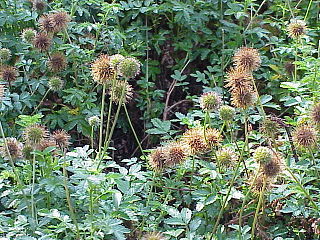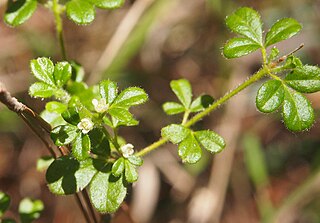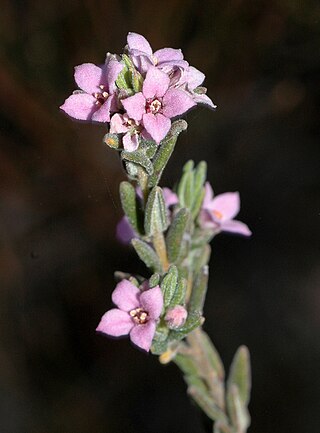
Nathaniel Lord Britton was an American botanist and taxonomist who co-founded the New York Botanical Garden in the Bronx, New York.

Acaena is a genus of about 60 species of mainly evergreen, creeping herbaceous perennial plants and subshrubs in the family Rosaceae, native mainly to the Southern Hemisphere, notably New Zealand, Australia and South America, but with a few species extending into the Northern Hemisphere, north to Hawaii and California.

Azorella is a genus of flowering plants in the family Apiaceae, native to South America, New Zealand, southeastern Australia, and the islands of the Southern Ocean.

Heinrich Gustav Adolf Engler was a German botanist. He is notable for his work on plant taxonomy and phytogeography, such as Die natürlichen Pflanzenfamilien, edited with Karl A. E. von Prantl.

The Marcgraviaceae are a neotropical angiosperm family in the order Ericales. The members of the family are shrubs, woody epiphytes, and lianas, with alternate, pinnately nerved leaves. The flowers are arranged in racemes. The flowers are accompanied by modified, fleshy, saccate bracts which produce nectar. The flowers are pentamerous. The fruits are capsules.

Triodia is a large genus of hummock grass endemic to Australia. The species of this genus are known by the common name spinifex, although they are not a part of the coastal genus Spinifex. Many soft-leaved Triodia species were formerly included in the genus Plectrachne. Triodia is known as tjanpi (grass) in central Australia, and have several traditional uses amongst the Aboriginal Australian peoples of the region.

Zieria is a genus of plants in the family, Rutaceae. About sixty species have been formally described, all of which are endemic to Australia except for one species which is found in New Caledonia. They occur in all Australian states except Western Australia but the genus is under review and a number of species are yet to be described or the description published. Zierias are similar to the better known genus Boronia but can be distinguished by the number of stamens in the flowers. The name Zieria honours the Polish botanist John Zier.

Celmisia is a genus of perennial herbs or subshrubs, in the family Asteraceae. Most of the species are endemic to New Zealand; several others are endemic to Australia.

Brachyglottis is a genus of flowering plants in the family Asteraceae. The genus was erected on November 29, 1775, by Johann Reinhold Forster and Georg Forster. The name was derived from the Greek brachus ("short") and glottis a reference to the size of the ray florets.

Schmidtia is a genus of Asian and African plants in the grass family.
Wayne P. Armstrong is a natural historian, author, photographer and creator of the extensive online natural history textbook, Wayne's Word: An Online Textbook Of Natural History.

Zieria arborescens, commonly known as the tree zieria or stinkwood, is a plant in the citrus family Rutaceae and is endemic to eastern Australia. It is a bushy shrub or small tree with branches that are ridged and scaly or hairy, at least when young. It has leaves composed of three leaflets and groups of flowers with four white petals, the groups usually shorter than the leaves.
Norman Brice Byrnes was an Australian botanist, specialising in taxonomy.

Zieria minutiflora, commonly known as twiggy zieria, is a plant in the citrus family Rutaceae and is endemic to eastern Australia. It is a small, erect, twiggy shrub with leaves composed of three leaflets, and clusters of small white flowers with four petals and four stamens. It usually grows as an understorey shrub in eucalypt woodland.

Zieria odorifera, commonly known as the fragrant zieria, is a plant in the citrus family Rutaceae and is endemic to inland New South Wales. It is an aromatic shrub with ridged branches, leaves composed of three leaflets and groups of mostly three pale to deep pink, four-petalled flowers in spring.

Zieria veronicea, commonly known as the pink zieria, is a plant in the citrus family Rutaceae and is endemic to south-eastern Australia. It is a small, lemon-scented shrub densely covered with velvety hairs. Up to three flowers with four pink petals appear in leaf axils in late spring.
Joan W. Nowicke is an American botanist from St. Louis, Missouri. She worked 27 years for the Smithsonian Institution, between 1972 and 1999, in the Department of Botany, from the National Museum of Natural History. Nowicke is a global reference as a palynologist, mainly due to her specialization in pollen morphology and its relationship with systematics, in addition to her extensive work in the area of Caryophyllales palynotaxonomy.

Veronica rakaiensis, the Rakai hebe, is a species of flowering plant in the family Plantaginaceae, native to the South Island of New Zealand. As its synonym Hebe rakaiensis it has gained the Royal Horticultural Society's Award of Garden Merit.














